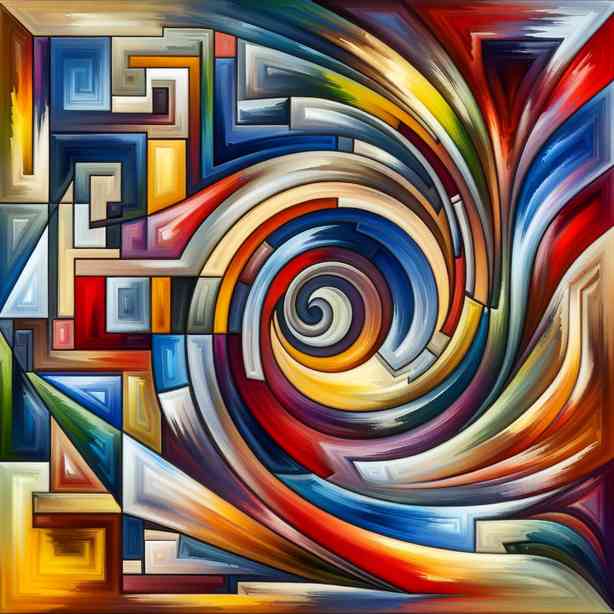
“The Painting That Was Supposed to Be Abstract” addresses a fascinating interplay between expectation and artistic expression. In a world where abstraction often reigns, the narrative surrounding a particular piece showcases the complexity of artistic interpretation and the essence of creativity. This discussion delves into the journey of the artwork, its creator, and the surrounding discourse, eventually unfolding the layers add depth to the seemingly simple title.
At first glance, abstract art may appear as chaotic, randomly placed colors and shapes, but it carries intricate emotions and thoughts from the artist. The origins of abstraction can be traced back to early 20th-century movements, where artists sought to deviate from traditional representations. They aimed to enable viewers to experience art through feelings rather than strict representation of reality. The painting in question was crafted around this philosophy, with the artist intending to evoke inspiration, provoke thought, and invite interaction.
The artist, who remains relatively anonymous, was influenced by the philosophical tenets prevalent during the rise of modernism. They immersed themselves in the works of pioneers like Wassily Kandinsky and Piet Mondrian, whose visionary approaches laid the groundwork for abstraction in art. The artist strove to channel these influences into a piece meant to represent the internal emotional landscape, a realm untouched by the constraints of reality.
As the painting came to life on the canvas, spontaneous gestures merged with deliberate strokes, creating an intricate dance between chaos and order. The artist believed that by layering colors, textures, and shapes, they could build an emotive dialogue between the artwork and the viewer. Each layer symbolized the myriad experiences that inform human existence, revealing that abstraction is not merely about the absence of recognizable forms but is a profound expression of thought and feeling.
Once unveiled to the public, expectations heightened. Individuals approached the piece hoping to glean insight into the artist’s mind. Would it be a reflection on solitude, a celebration of connectedness, or perhaps a question posed to humanity about the nature of existence? Interpretations varied widely, with viewers projecting their values and experiences onto the canvas. Some found themselves captivated by the vibrant colors, while others were drawn into the intricacies of the shapes.
However, despite the intended abstraction, reactions to the painting revealed something intriguing. Many viewers dismissed it as overly simplistic or too chaotic, failing to engage with the nuances the artist embedded within it. This led to a conversation about connection and communication in art. Can an artist truly expect others to understand their vision, or is the interpretation always up for discussion? The art of abstraction lies in its elusiveness, redefining what it means to perceive and engage with a painting.
As critiques poured in, the artist faced a challenging dichotomy: the painting was celebrated for its emotional depth by some, while others deemed it a failure to encapsulate the essence of abstraction. Understandably, this polarized reception sparked contemplation regarding the nature of artistic intention versus viewer perception. While creators often aim to infuse a narrative, each observer’s context uniquely influences how they interact with the artwork.
At the heart of this discussion is the question of meaning. In the realm of abstract expression, meaning often exists in the viewer’s interpretation. The artist may pour their soul into balancing hues and forms, yet the painting becomes a mirror, reflecting the lives and experiences of those who encounter it. Hence, the painting was not simply a composition on canvas; it became a multifaceted hub of human interaction.
The implications of this dialogue extend beyond visual art; they invite deeper consideration for artistic expression across mediums. Literature, music, and performance art share similar challenges where intent can diverge widely from audience reception. This painting serves as a poignant reminder of the unpredictable nature of creativity, highlighting that art is not merely a presentation of ideas but an ongoing conversation across time and space.
Furthermore, to understand a piece like this requires openness and willingness to explore beyond surface meanings. It asks observers to let go of preconceived notions and embrace the disorientation that often comes with true abstraction. This invitation to dive deeper resonates with anyone seeking to cultivate a more profound understanding of what art can be. It nurtures empathy towards creators while acknowledging that meanings carried through art demand engagement and reflection.
As the public grappled with their impressions of the artwork, the dialogues became broader, encompassing themes of identity, culture, and societal norms. The painting stood at a crossroads of individual experience and collective understanding, showcasing that abstraction powerfully reflects the complexity of human existence.
By facilitating these discussions, the painting served a greater purpose than maintaining aesthetic appeal. It prompted questions about the role of artists in society and how their work navigates the turbulent waters of interpretation and critique. The artist, post-exhibition, reflected on the experience and noted that the most thought-provoking art would inevitably evoke mixed responses.
Such reflections laid the foundation for future works, pushing the boundaries of how abstraction could be expressed, communicated, and appreciated. It encouraged an iterative practice where each painting could continue the conversation initiated by its predecessors. Embracing the power of feedback, the artist recognized that every critique offered a fresh perspective and a chance to iterate upon the last.
In conclusion, “The Painting That Was Supposed to Be Abstract” unveils the multifaceted exploration of art, perception, and expression. As the boundaries between the artist’s intent and viewer interpretation blur, this painting encapsulates a shared journey towards understanding the broader human experience through abstraction. Ultimately, it serves as a reminder that art transcends mere visual experience, engaging with the depths of emotion and thought that define us.
The legacy of this painting and the discussions it inspires lays the groundwork for future explorations into the realms of abstraction. By embracing both its complexity and simplicity, we find a canvas that reflects not just colors and shapes but the essence of human connection—a vital thread woven through the fabric of art itself.


